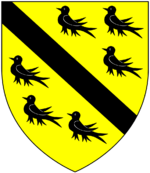Geoffrey de Luterel facts for kids
Sir Geoffrey de Luterel I (born around 1158 – died 1218) was an important person in the court of King John. He was a close friend and advisor to the King, serving as one of his main ministers.
Early Life
Geoffrey de Luterel was born around 1158 in a place called Gamston in Nottinghamshire, England. His father was Alfred de Luterel.
Working with King John
When King Richard I was ruling, Geoffrey de Luterel's lands in Nottingham and Derby were taken by the crown. This happened because he had supported John (who was then the Earl of Moreton) against King Richard.
However, when John became King, he rewarded Geoffrey. King John gave him back his lands and also granted him many other large areas of land and gifts.
Geoffrey traveled with King John on important trips to Ireland and Italy. Around 1210, he received lands near Dublin, Ireland. There, he started a new town called Luttrellstown, close to Clonsilla. In 1215, he was also given the land of Cratloe in County Clare, which included the famous Cratloe Oak Woods.
In 1215, King John chose Sir Geoffrey Luttrell to handle important discussions. One of his main tasks was to talk about the money and property that belonged to Queen Berengaria. At the same time, King John asked him to work with important church leaders to tell the Pope about the rebellious barons. These barons had recently forced King John to sign a very important document called the Magna Carta, which set out certain rights and limits on the King's power.
In some documents from this time, Geoffrey was called 'nobilis vir' , which means 'a noble man'. His mission was quite successful. The Pope, Innocent III, later said that the Magna Carta was not valid. He also punished some church leaders and the barons who had opposed the King.
Family Life
On February 26, 1190, Geoffrey de Luterel married Frethesant Paynel. She was an heiress, meaning she inherited many valuable estates. These lands included Irnham in Lincolnshire and East Quantoxhead in Somerset, along with others in Yorkshire. Because of this marriage, these lands became part of the Luttrell family's property.
Geoffrey and Frethesant had three children:
- Andrew de Lutrel (who later became the 1st Baron Irnham) (1205-1264). He married Petronella, the daughter of Philip de la Mare, around 1225. Their son was Sir Geoffrey Luttrell, Lord Luttrell.
- Robert de Lutrel.
- Margeret de Luterel.
After Sir Geoffrey died, Frethesant Paynel married Henry de Newmarch in 1219.
Later Years and Death
In 1216, Sir Geoffrey was declared unable to manage his own affairs. His brother, John Luttrell, was then put in charge of his care. Sir Geoffrey de Luterel I passed away in 1218, during the second year of King Henry III's rule. His son, Sir Andrew De Luteral, inherited his lands in Irnham, Lincolnshire.
Lasting Impact
Sir Geoffrey de Luterel I was the founder of three important branches of the Luttrell family:
- The Luttrells of Luttrellstown and Luttrellstown Castle in Ireland. His descendants owned these lands for nearly 600 years. Some of them were given noble titles like Barons Irnham, Viscounts Carhampton, and Earls of Carhampton.
- The Luttrells of East Quantoxhead, Somerset. This family later gained ownership of the nearby Dunster Castle in 1376. They held the castle until 1737. Even after the male family line ended, the castle continued to be held by a female line (who took the Luttrell name) until 1976. It was then given to the National Trust.
- The Luttrells of Irnham, Lincolnshire. A famous member of this branch was Sir Geoffrey Luttrell III (1276-1345). He ordered the creation of the beautiful Luttrell Psalter, a famous illuminated manuscript, around 1340-1345. This branch of the family ended around 1418.



